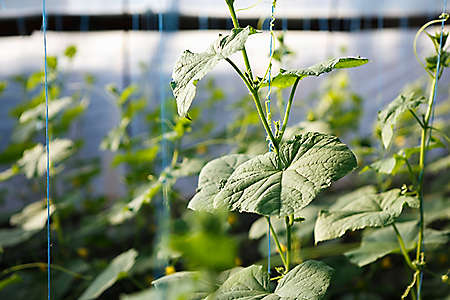Are you noticing small, white, winged insects gathering around your plants? You might be dealing with a whitefly infestation. These tiny pests can wreak havoc on crops and greenhouse plants, posing a major challenge for growers. Here’s everything you need to know about identifying whiteflies, understanding their lifecycle, and learning about five of the most common species.
What are whiteflies?
Whiteflies belong to a group of over 1,500 species of soft-bodied, fly-like insects. They get their name from the powdery white wax that coats adult whiteflies. Though small, these insects can multiply rapidly, making infestations difficult to control. They are infamous for spreading plant diseases and damaging a wide range of crops, increasing the burden on growers worldwide.
How do whiteflies damage plants?
Whiteflies use their piercing-sucking mouthparts to feed on the sap from plants’ phloem, the tissue responsible for transporting nutrients. As they siphon vital fluids, they weaken plants, causing yellowing, wilting, and premature leaf drop. Severe infestations can lead to stem blanching, stunted growth, reduced crop yield, and even complete plant death.
Beyond direct feeding damage, whiteflies also excrete a sticky substance called honeydew, which encourages the growth of sooty mold. In extreme cases, this mold prevents sunlight from reaching the leaves, inhibiting photosynthesis and further harming the plant.
Plant diseases carried by whiteflies
Whiteflies are notorious vectors of plant diseases. Some species, particularly those in the Bemisia genus, spread yellow mosaic diseases affecting over 20 different plant species. Another common disease carried by whiteflies is Begomovirus, which causes leaf curling, vein yellowing, and stunted growth. These infections can result in significant crop loss and make plants unsuitable for sale or consumption, making whitefly management a priority for growers.
Five common types of whiteflies
While numerous species exist, here are five common types growers often encounter:
1. Greenhouse Whitefly
Trialeurodes vaporariorum
Description: White wings and yellow body surface with triangular overall shape when wings are flat against body.
Characteristics: Cannot survive in colder temperatures outside of greenhouses.
Common host plants: Cucurbits, leafy greens, geranium, aster, tomatoes, gardenias, poinsettias, and hibiscus.

2. Silverleaf/Sweet Potato Whitefly
Bemisia tabaci
Description: Yellow body with white wings that are vertically tilted creating a ‘tent’ shape.
Characteristics: Nymphs have a distinctive Y-shape on their backs.
Host plants: Many woody and herbaceous vegitation including sweet potatoes, tomatoes, peppers, cotton, cucurbits, roses, and poinsettias.
Typically found in Southern states and areas of warmth/humidty.

3. Banded Winged Whitefly
Trialeurodes abutilonea
Description: Two distinct gray zigzag lines on the wings.
Characteristics: Able to survive outdoors in the winter in Southern States.
Host plants: Ornamental plants such as cotton, hibiscus, poinsettia, geranium, petunia, fuchsia, citrus and eucalyptus.

4. Giant Whitefly
Aleurodicus dugesii
Description: Yellow bodied and white wings with light grey/brown irregularly shaped markings.
Characteristics: Can grow up to 3/16 of an inch long.
Host plants: Commonly found on ornamentals and fruit trees in the US such as avocado, banana, citrus and hibiscus.

5. Citrus Whitefly
Dialeurodes citri
Description: White body and wings.
Characteristics: Favor warmer climates and can thrive on flat waxy leaf surfaces.
Host plants: All citrus trees, coffee, English ivy, lilac, cherry trees, and a wide range of ornamentals and vegetables.

Understanding the life cycle of whiteflies
Whiteflies are a persistent challenge for growers, often mistaken for flies or moths. However, these tiny pests are actually related to aphids, scales, and mealybugs—all belonging to the order Hemiptera. With rapid reproduction rates and the ability to thrive in warm conditions, whiteflies can quickly become a major threat to crops and greenhouse plants.
The whitefly reproductive cycle
Female whiteflies lay 6 to 20 eggs per day, typically on the underside of leaves. These tiny eggs start out white or yellow, then gradually darken to brown as they mature. Once hatched, the young nymphs go through four distinct stages, feeding on the host plant throughout their development.
Stages of growth
- Egg Stage (0-10 Days) – Eggs hatch within 7 to 10 days, releasing tiny crawlers that begin searching for a feeding site.
- Crawling Nymphs – Newly hatched whiteflies move around briefly before settling in for the next two developmental stages.
- Final Instar (Often Called "Pupa") – While whiteflies do not undergo a true pupal stage, their final instar is frequently referred to as one.
- Adult Stage – Both nymphs and adults continue feeding on plant juices, weakening the host plant.
How fast do whiteflies develop?
Whiteflies thrive in warmer conditions, accelerating their growth cycle. At 82°F (28°C), they can complete their full life cycle in as little as 18 days. This rapid development means multiple generations can emerge throughout the year, making infestations even harder to control—especially in warm climates where whiteflies can remain active year-round.
Scouting practices to avoid whiteflies infestation
This group of insects favor newer growth and the undersides of leaves for egg laying. Check under leaves, especially around the veins of the plant for small yellow or brown eggs. The whitefly larvae or immatures, commonly referred to as whitefly nymphs, will look like tiny white ovals, and do not move around much after the eggs hatch. Both the eggs and nymphs can be found on the undersides of the leaves.

These insects tend to aggregate in large numbers and infestations will be easy to find. Females can lay 100 – 400 eggs in their lifetime. Their numbers can grow rapidly which is why preventative measures should be used to keep these infestations from growing.
Adult whitefly tend to be attracted to yellow and white surfaces. Yellow and white sticky traps are commonly used to monitor the pest populations. Chemical applications, both conventional and organic, can be used to keep the populations low in the field and in greenhouses. Consistent and repeated use of the same chemical can increase the likelihood of the insect developing resistance to pesticides.
Conquer the threat of whiteflies and other pests with our crop protection products.

Tatiana Giacinti, Product Manager – Kemin Crop Technologies
With over fifteen years of B2B experience, Tatiana offers extensive expertise as a Product and Marketing Manager with a proven track record in the biotechnology sector.
Subscribe to our blog

Six Tips For Building A Successful Pest Scouting Method

Six Tips for a More Effective and Safe Pesticide Spray Coverage

Insight: Shortage of beneficial insects during the pandemic
